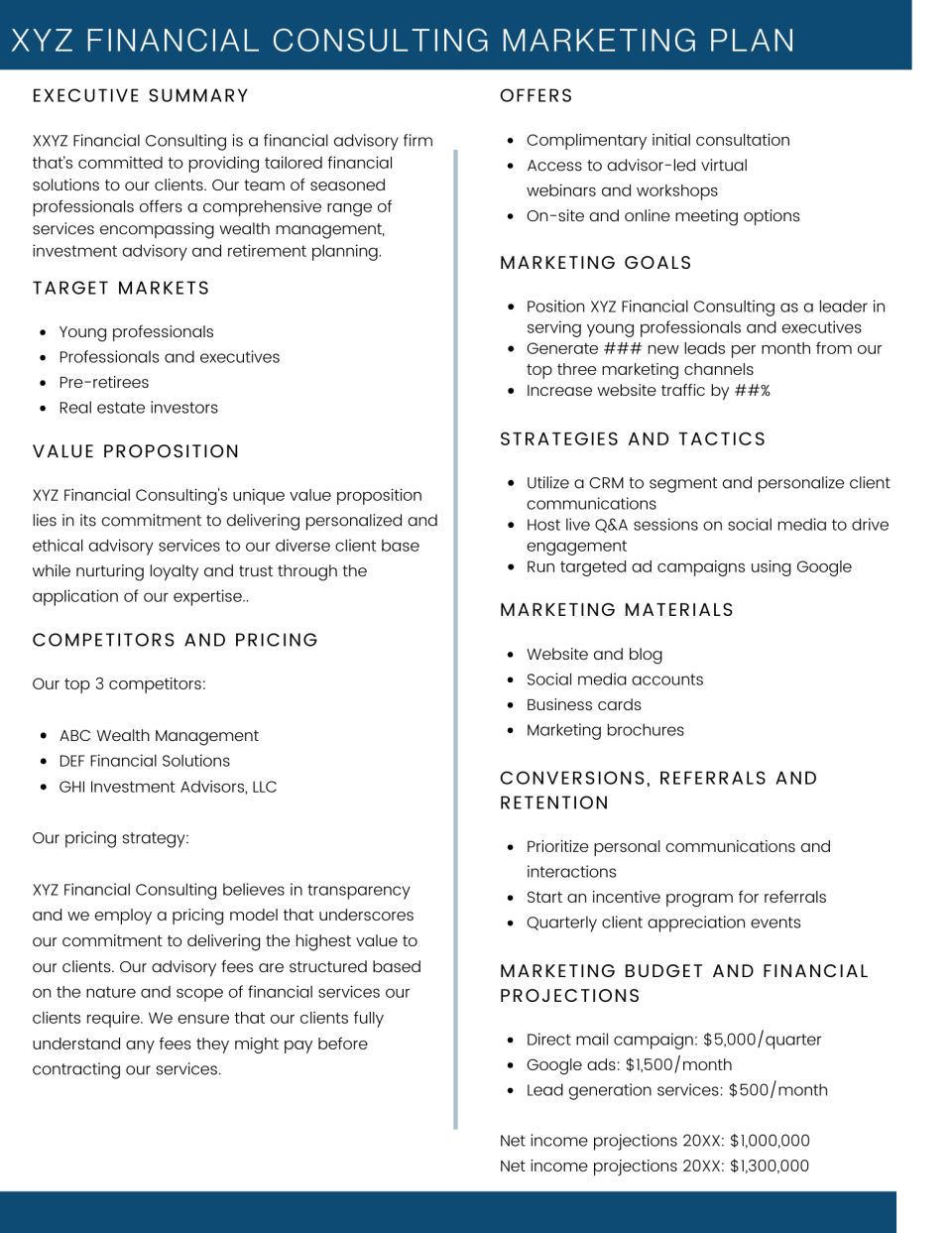Example: How to Create an Effective Financial Advisor Marketing Plan in 2024

Whether you have a new advisory firm or an established one, you need a marketing plan. Proper marketing can help you attract your ideal clients, establish your brand's credibility and reputation and increase conversions. But what should you include? Having a financial advisor marketing plan example to follow can help you craft a tailored strategy for your business.
Ready to grow your client base? Let SmartAdvisor simplify the lead generation process.
What Is a Financial Advisor Marketing Plan?
Your marketing plan is a detailed framework for how you plan to promote and scale your advisory business. Financial advisor marketing plans are usually written with both broad and specific goals in mind.
For example, your big goal may be to scale your firm to $1 million a year in revenue. That's supported by several smaller goals, such as:
Generating five new leads per week
Attracting 5,000 visitors to your advisor website per month
Increasing engagement on social media by 10% each month
Writing out a marketing plan allows you to define, and then refine, what you want to achieve in your business. Once you have some clear goals in sight you can break each one down into specific actionable steps to market your firm.
Why Financial Advisors Need a Marketing Plan
Writing a marketing plan isn't a requirement to be an advisor, but there are some excellent reasons to invest some time in creating one.
When you have a clear marketing plan, it becomes easier to:
Direct your energy toward actions that are designed to produce results and eliminate time- and money-wasters
Clarify your brand messaging and what it is you do as an advisor, as well as who you serve
Target your efforts toward those channels where your ideal clients spend the most time
Evaluate the competition to see what they're doing right (or wrong) to attract clients
Track key metrics to identify the actions that are working and ones that are falling short of your expectations
While trial-and-error methods can yield some valuable lessons, a proper marketing plan can help you avoid potentially costly mistakes as you work on scaling your business.
What to Include in a Financial Advisor Marketing Plan

Every advisor's marketing plan is different. At a minimum, a financial advisor marketing plan should include these sections:
Executive summary
Target market
Value proposition
Competitors and pricing
Offers
Marketing goals
Marketing strategy and tactics
Marketing materials
Conversion, referrals and retention.
Marketing budget and financial projections
Let’s take a closer look at how each one works:
Executive Summary
Your executive summary should offer an overview of the main points covered in the rest of your marketing plan. For example, you'd include your marketing goals here along with your projected results.
If you've created any visual elements, such as charts, graphs or tables, you could include those here as well. Though it's the first thing anyone reading your plan will see, it typically makes sense to write this section last after you've filled in the rest of your plan.
Target Market
Your target market represents who you hope to connect with through your marketing efforts. For instance, you may choose to segment potential clients based on age, geography, net worth or another characteristic.
Your marketing plan should include a detailed description of each segment and how you selected them. You can also create a buyer persona that represents each segment, which you can use as a guide when detailing your marketing strategies and tactics.
Value Proposition
Who are you and what makes your company different? Those are the questions you should aim to answer in this section of your marketing plan.
If you're not able to clearly define what makes your firm valuable to your ideal client, you're going to have a much harder time convincing them to choose your services over a competitor's. It's worth investing some time in drilling down on what makes your business unique.
Completing a market analysis can help you do that.
Competitors and Pricing
The financial services landscape is vast, and your marketing plan should consider what your competitors bring to the table. Ask yourself who your top three to five competitors are, then look at their value proposition.
How does it compare with yours? How are they conveying it through their branding and marketing materials? What's their position in the overall market and how are they perceived?
Once you've answered those questions go back to your marketing plan and consider how you want potential clients to view your business. Thinking about what problems they have and how you're uniquely equipped to solve them can help shape your marketing approach.
While you're checking out the competition, remember to consider pricing as well. How do you price your services relative to your competitors? And how does your pricing model benefit your clients? The goal here is to pinpoint exactly what it is that makes you different.
Offers
Prospective clients are looking for solutions and your marketing plan should convey what you have to offer. That includes the types of services you provide as well as any products you offer.
Again, it's helpful to pick out what's unique about your business. For example, do you offer interactive tools to help clients manage their accounts? Exclusive discounts for bundling services? Incentives for referrals?
Those are all things a prospective client might like to know but they won't be aware of them if you're not highlighting those benefits in your marketing.
Marketing Goals
Your marketing plan should define what your goals are. And there's a simple rule of thumb for setting goals as a financial advisor: Make them SMART.
SMART goals are:
Specific
Measurable
Achievable
Relevant
Time-bound
Setting a goal of generating $1 million in revenue in a year meets the criteria because it's specific, you can measure your progress, it's relevant to your business growth and you're giving yourself a deadline. The achievable element comes in when you develop tactics for implementing your marketing strategies.
Marketing Strategy and Tactics
Your marketing strategy is the larger umbrella that encompasses how you plan to promote your business, while your tactics are the action steps you'll take to do that. These steps may include:
Building out website and blog content
Growing your social media following
Launching a direct mail marketing campaign
Marketing to your email list
Offering yourself as an expert source for news articles or podcasts relevant to your niche
Taking on speaking engagements
Attending conventions, trade shows, conferences and other networking events
Hosting an online seminar
Marketing locally through community events or print advertising
In addition to outlining your strategies and tactics, you can also detail how much attention each one will get.
For example, you might set a goal of being a guest on one podcast per month or attending two financial advisor conferences per year. Or if you're focused on digital marketing, you may set a baseline target for the number of original blog posts or articles you plan to publish each month or how frequently you plan to send out emails to your list.
Marketing Materials
Your marketing materials represent the tangible and intangible things you'll use to promote your advisory business. These can include:
Business cards
Brochures or flyers
Print newsletters (if you're engaging in direct mail marketing)
Email newsletters
A website or blog
Written social media content
Video content
Whitepapers or case studies
If you're testing any outside-the-box strategies with marketing materials, you could mention them here. For example, say you're doing some A/B testing with business cards. You have one that's a traditional business card and a second one that includes a QR code that takes you to your firm's website when scanned.
Including that in your marketing plan could give you a useful metric to track to see which one ends up generating more leads. You can then use what you learn to adjust your plan going forward.
Conversion, Referrals and Retention
The bulk of your marketing plan may detail how you plan to attract prospects, but you also need to consider how you're going to convert them and retain them once they become clients.
For example, if you have a website and are using email marketing, what incentive do you offer to get people to sign up for your list? While you're not required to offer anything, having an attractive lead magnet, such as access to a free online wealth planning workshop or an e-book, can give prospects a compelling reason to hand over their email address.
If you hope to gain referrals, consider what reasons your clients would have to tell their friends, family members or coworkers about you. Aside from that, think about how you plan to ask for those referrals, whether that be on your website, through email marketing, direct mail marketing or social media.
You may decide to incentivize referrals by offering a discount on services. Or you may establish a loyalty program and hold client appreciation events as a reward for sticking with your services. All of that belongs in your marketing plan.
Marketing Budget and Financial Projections
Last but not least, your marketing plan should cover how much you plan to spend to promote your business, where that money is going and what you expect to get in return.
Creating a visual, such as a pie chart, can make it easier to see exactly where the money in your marketing budget goes. You can then compare the percentages you're spending on email marketing, digital marketing, social media, etc. to the revenue each one generates for you.
If you notice that you're spending a lot on a specific marketing channel but getting little back on your investment, you can adjust your budget accordingly to redirect those funds elsewhere. For example, you may find that you derive more value from investing in an online lead generation tool versus ads on local television.
Your marketing plan should also include some of the same information you'd put in your business plan. For example, you'd want to attach a balance sheet, cash flow statement and income statement and update them each time you update your marketing plan.
Bottom Line

Having a financial advisor marketing plan example to follow can make developing your own less overwhelming. As your business grows it's a good idea to revisit your plan periodically to make sure the strategies you're using are still working.
Tips for Growing Your Advisory Business
Implementing a marketing plan can be a time-consuming process and it's something you might consider outsourcing to a professional marketing firm for financial advisors. If you decide to take that route, it's helpful to consider the range of services offered and the fees you'll pay to gain exposure for your business. If you're looking for a faster route to connecting with clients, SmartAdvisor can help. SmartAdvisor brings leads to you and equips you with everything you need to follow up.
Developing a marketing plan yourself can save money if you're not paying an agency's fees. However, if you're unsure of what to include or want a second set of eyes to look over your plan you may consider scheduling a one-time meeting with a marketing consultant.
Photo credit: ©iStock/Dragos Condrea, ©Rebecca Lake, ©iStock/master1305
The post Example of an Effective Financial Advisor Marketing Plan appeared first on SmartReads by SmartAsset.
